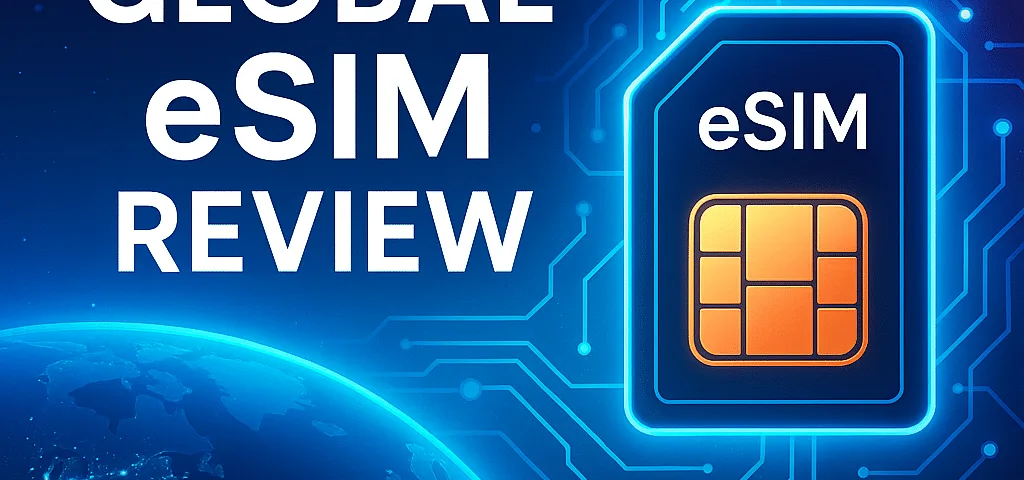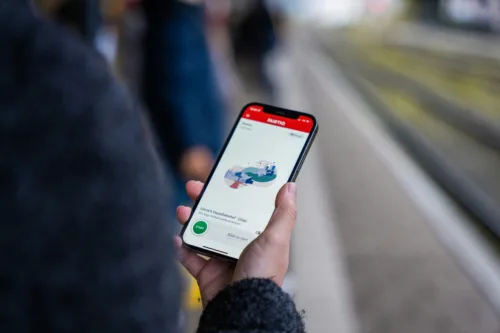
How Many eSIM Can Your iPhone Store?
October 20, 2025
Finding Local Gems Abroad – Great Places to Travel To
November 3, 2025Let’s Talk About the Future of Travel Connectivity
You’ve probably seen ads promising “instant global internet in seconds” or influencers showing off how they switch countries without ever touching a SIM card. That’s what today’s post is all about — a global eSIM review that actually tells you what works, what doesn’t, and whether this futuristic tech is worth your money in 2025.
We’re living in a world where travel is easier, but staying connected still costs a fortune. Between roaming charges, unreliable Wi-Fi, and confusing prepaid SIMs at airports, there’s a new hero in town: the global eSIM.
This global eSIM review breaks down everything — who should use it, how it works, where it’s available, and why so many travelers are ditching physical SIMs. You’ll also find comparisons, hidden costs, activation tips, and honest feedback from real users. So, if you’ve ever typed “best global eSIM for travel” or “global eSIM review 2025” into Google, this blog was written exactly for you.
Who Should Care About a Global eSIM Review?
Let’s start with the big question — who really benefits from reading this global eSIM review?
If you’re a frequent traveler, digital nomad, or remote worker, this might just be your favorite tech upgrade of the year. A global eSIM is built for anyone tired of changing SIM cards every time they cross a border. Whether you’re heading from Paris to Tokyo, or hopping between New York and Bangkok, a single plan can keep you online.
But it’s not just travelers. This global eSIM review also matters for entrepreneurs managing teams abroad, families sending kids on study programs, and even influencers constantly on the go. Basically, if you value seamless data connectivity without the SIM-card shuffle, this review is for you.
What Is a Global eSIM, Really?
In simple words — a global eSIM is a digital SIM card. No physical chip, no store visits, no poking your phone with a metal pin. You scan a QR code, and boom — your phone gets a new data plan.
Unlike a local eSIM that works only in one country, a global eSIM connects you across dozens or even hundreds of countries with a single data package. It’s like having one passport for the entire world, but for mobile data.
Here’s what you get:
A single plan that works in multiple countries.
Instant activation via QR code.
No contracts or hidden roaming fees.
Compatibility with most modern phones (iPhone 11 and above, Samsung S20+, Google Pixel 7, etc.). Check compatibility.
So in this global eSIM review, we’ll test whether that “global” promise really holds up in real-world travel.

Why Choose a Global eSIM in 2025?
This part of the global eSIM review answers the why. Because yes, physical SIMs still exist — but they’re starting to feel like using floppy disks in a world of cloud storage.
1. Convenience:
No need to hunt down a local SIM shop when you land. Your data is live before you leave the airport.
2. Affordability:
A global eSIM plan saves you up to 85% compared to standard roaming rates. Many users now travel with Strong eSIM, Airalo, Nomad, or Holafly — popular names in every global eSIM review out there.
3. Flexibility:
Switch plans in seconds. You can even keep your WhatsApp or iMessage number while your data runs on the eSIM.
4. Eco-friendly:
No more plastic SIMs or waste packaging. It’s digital, cleaner, and future-ready.
So why 2025? Because network coverage has exploded. Providers now support 5G global eSIM networks, faster than ever before. This global eSIM review reflects those improvements — what was once “experimental” in 2021 is now mainstream.
Where Does a Global eSIM Work?
Here’s where this global eSIM review gets exciting. Most top providers offer coverage in over 190 countries. Yes, that’s basically the whole planet — minus maybe Antarctica.
You’ll find global eSIM coverage across the U.S., Canada, Europe, Asia, the Middle East, and even Africa. The best part? You don’t have to manually switch profiles when crossing borders. It automatically connects to the strongest partner network.
However, coverage quality still depends on the provider. Based on 2025 data:
Strong eSIM – Excellent coverage and real 5G speeds in Europe & North America.
Airalo – Great for casual travelers, solid app experience.
Nomad – Competitive pricing but sometimes slower support.
Holafly – Unlimited data options but not always full speed.
So when people search “global eSIM review” or “best global eSIM providers 2025”, these are the names they’ll find most often.
How Does a Global eSIM Work?
Technically speaking, eSIM stands for Embedded SIM — it’s a small chip built into your device that stores your carrier profile digitally.
Here’s how it usually works:
You buy a global eSIM plan from a provider.
You receive a QR code by email or app.
You scan it with your phone’s camera.
Within minutes, your new international data plan activates.
No stores, no paperwork, no ID verification delays.
In this global eSIM review, setup simplicity is one of the biggest wins. Travelers love being able to land, turn off airplane mode, and instantly connect.

Should You Try a Global eSIM?
So here’s the honest verdict of this global eSIM review — yes, you should absolutely try it, but with a few smart tips.
Pros
Instant activation anywhere.
Affordable global data.
Works on all modern devices.
Environmentally friendly.
Cons
Some regions still have slower data (e.g., parts of Africa).
iPhone dual-SIM setup can confuse beginners.
Not ideal for people who need local phone numbers.
If your main goal is reliable travel data, a global eSIM is worth every penny. You’ll wonder how you ever lived without it.
How Much Does a Global eSIM Cost?
Every global eSIM review eventually comes to this part — the pricing.
Most global eSIM plans are prepaid, meaning no surprise bills. Here’s a quick example (2025 prices):
1 GB / 7 days – $5 USD
3 GB / 15 days – $9 USD
5 GB / 30 days – $15 USD
Unlimited / 30 days – $39 USD
Costs vary by provider and coverage region. The good news? Many eSIM companies now offer regional bundles — like Asia + Europe or Americas + Oceania — for travelers who don’t need full global access.
Also, keep an eye out for hidden costs like “top-up fees” or “fair use policies.” In this global eSIM review, we found Strong eSIM and Airalo to be the most transparent about pricing.
Global eSIM vs Local SIM
No global eSIM review is complete without this comparison.
| Feature | Global eSIM | Local SIM |
|---|---|---|
| Activation | Instant via QR code | Manual in store |
| Coverage | 100+ countries | Single country |
| Cost Control | Prepaid + transparent | Often hidden roaming |
| Setup Time | 2 minutes | 20 minutes |
| Eco Impact | Zero plastic | Physical waste |
If you travel frequently, the global option wins every time. Local SIMs might still be cheaper for long stays, but not by much anymore.
Real User Experiences
Based on feedback across Reddit, Trustpilot, and travel forums in 2025, here’s what people say:
“My Strong eSIM connected instantly in Italy and France. No drops.”
“Nomad worked well, but slower in Thailand.”
“Holafly was okay, but their unlimited plan throttles speed after a few GB.”
This global eSIM review combines those community insights so you get the real picture not just marketing promises.
Conclusion – The Final Word in This Global eSIM Review
After testing, comparing, and digging into the details, here’s the final takeaway of our global eSIM review:
If you travel often, value simplicity, and hate surprise roaming bills, a global eSIM is one of the smartest upgrades you can make in 2025. It’s faster, cleaner, and far more convenient than juggling physical SIM cards.
Among top providers, Strong eSIM continues to stand out for its transparent pricing, stable connections, and wide 5G coverage. Whether you’re off for a weekend trip or a year-long adventure, it’s a travel hack that actually works.
So go ahead — scan that QR code, pack your bags, and step confidently into the borderless era of mobile data. The world’s connected, and now, so are you.


